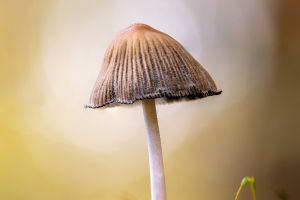Bioluminescence is a phenomenon where living organisms can emit light. We may be familiar with jellyfish and fireflies, but bacteria, fungi, insects, and fish can also emit light through various chemical methods.
As early as 1840, the world's brightest fluorescent mushroom was first discovered in Brazil, according to scientific literature. At that time, the British botanist George Gardner saw children playing in the street with this mushroom, and initially thought it was fireflies. However, it turned out to be fluorescent mushrooms.
Among the many exotic things that can be found in forests, mushrooms are one of the most unique. They germinate in humid, shady places, and many of them are highly poisonous. One of their strangest features is that they glow at night, which is not common in plants.
Scientists have identified more than 80 species of luminous mushrooms among the more than 100,000 known species of mushrooms. Most of them belong to the category of luminescent navel mushrooms, armillaria, and dendrobium mushrooms. These mushrooms emit green light with a wavelength of 520-530 nanometers.
The luminescent parts of the mushrooms include mycelium and mycelium threads, both of which emit light at the same time. For example, the mycelium and mycelium of the luminous navel mushroom and the small mushroom of Dendrobium can emit light, but only the mycelium of Armillaria can emit light.
One might think that these mushrooms glow all the time, but they only glow during a certain period of their life. During other periods of life, the mushroom does not emit any light, and the mycelium and hyphae threads glow brighter in early life than in late life.
So why do glowing mushrooms glow? After researching, scientists have isolated luciferin and luciferase from luminescent mushrooms. The fluorescence of luminescent mushrooms comes from an antioxidant called milk tree.
However, an enzymatic reaction must be used. Milk tree is first converted into real luciferin by hydroxylase, and then luciferin is oxidized to emit light in the enzymatic reaction of luciferase. In this way, the secret of the glowing mushroom is revealed.
Researchers also found that the luminosity and persistence of luminous mushrooms are restricted by ambient temperature and moisture and are also influenced by the nutritional conditions and aging state of the mushroom itself.
It is generally speculated that mushrooms use light to attract specific insects to help them spread their spores. In addition to attracting insects to scatter spores, glowing mushrooms may have other biological functions. For example, glowing mushrooms can use fluorescent signals to communicate with other organisms.
In some cases, fluorescent signals can also be used to scare away potential herbivores or predators. The fluorescent signals of luminescent mushrooms can also be used to attract other organisms to live with them, such as the symbiotic relationship between certain mushrooms and insects or fungi.
The fluorescent signal of glowing mushrooms also has some practical applications. For example, luciferin in fluorescent mushrooms can be used to prepare experimental tools such as bioluminescent reagents and fluorescent probes.
Fluorescent mushrooms themselves are also used in fluorescence imaging, fluorescence detection, and other fields. The chemical components in glowing mushrooms have some potential medical and biotechnological applications, such as antioxidants and antitumor agents.
Luminescent mushrooms are mysterious and fascinating organisms, and their luminescent phenomenon has aroused extensive interest and research among scientists.
Through the study of luminescent mushrooms, we can not only better understand the diversity and evolution of life but also provide new inspiration and ideas for human biotechnology and medical research.


